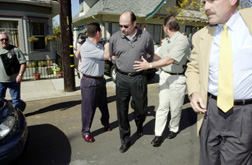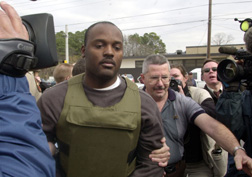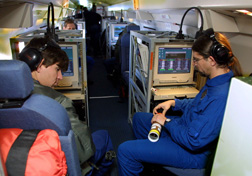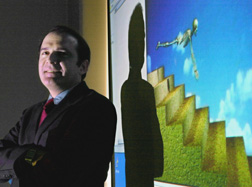Neighbor of missing San Diego girl is taken into custody
By BEN FOX
Associated Press
 |
|
AP Photo/John McCutcheon
David Westerfield is taken into custody and led away from his
lawyer’s office in San Diego
Friday. |
SAN DIEGO — A
neighbor of a 7-year-old girl abducted from her bedroom three weeks ago
was arrested Friday after her blood was found on his clothing and in his
motor home, police said. The girl was still missing.
David Westerfield,
49, was taken into custody for investigation of kidnapping in the
disappearance of Danielle van Dam, who vanished in the middle of the
night.
Police Chief David Bejarano said DNA tests confirmed the blood
in his vehicle and on a piece of his clothing was the girl’s.
“I can’t
stress enough how strong that link is,” the chief said.
Westerfield’s
attorney, Steven Feldman, said he will likely ask a judge to impose a gag
order on those involved in the case.
“We certainly intend to mount a
vigorous defense but we don’t wish to try the case in the media,” he
said.
Danielle was reported missing from her second-story bedroom the
morning of Feb. 2 when her parents went to check on her.
Bejarano would
not offer any details about what may have happened to the girl and would
not discuss why she was kidnapped.
“We are very happy that police have
made an arrest... But the fact still remains that we don’t have our
daughter. We still need to find Danielle,” the girl’s mother, Brenda van
Dam, said outside the family home.
Search leaders made a renewed plea
for more volunteers over the weekend.
Bejarano said police have no
conclusive evidence on whether she is alive, but added, “As a father, I’m
optimistic that at some point we will find Danielle.”
Police have
questioned Westerfield several times in the case. His sport utility
vehicle, motor home and other property has been impounded.
Police said
Friday that child pornography was found in his home.
Westerfield, a
self-employed engineer and divorced father who lives two doors down,
appeared calm as he was led into an unmarked police car.
Damon van Dam,
the girl’s father, has previously said that the family did not know
Westerfield well.
“He’s an acquaintance. He’s not a friend,” van Dam
said. “We’ve seen him since we moved in. We wave to him. We say hello to
him when we drive by.”
Westerfield was transferred to San Diego County
jail after questioning. He is expected to be arraigned
Tuesday.
Westerfield has told reporters that he saw Brenda van Dam at a
bar near their home the night before Danielle was reported missing.
Westerfield also said he went away that weekend and later showed police
the locations in the desert east of San Diego.
Danielle was last seen
when Damon van Dam put her to bed about 10 p.m. on Feb. 1. He stayed home
with Danielle and her two brothers while Brenda was at the bar.
Brenda
van Dam came home around 2:30 a.m., then stayed up for an hour with her
husband and friends. She said she made sure the children’s bedroom doors
were closed to keep from disturbing them, but didn’t check on the
children.
Threats made against crematory operator
 |
|
AP Photo/John Bazemore
Tri-State crematory owner Ray Brent Marsh is led past news
cameras by Walker County Sheriff’s deputies as he arrives for a
court hearing Friday in Lafayette, Ga.
|
NOBLE, Ga. (AP) — A judge
declined to set bail Friday for the operator of a north Georgia crematory
where nearly 300 decaying bodies have been discovered.
Magistrate Judge
Jerry Day said he would decide in the next few days whether Ray Brent
Marsh should be eligible for bail.
Prosecutors argued Marsh should not
be released because of the outrage in the community. Walker County Sheriff
Steve Wilson said death threats had been called in against
Marsh.
Marsh’s attorney, Ken Poston, said his client was not a flight
risk and had lived in the community all his life. He said concern for
Marsh’s safety was no reason to deny him freedom.
Poston said Marsh had
no intention of leaving town, or going back to his family’s crematory, if
he is released on bail.
“He’s not going anywhere near his home,” Poston
said.
Marsh, wearing a bulletproof vest, sat quietly during the
hearing, occasionally consulting with his attorney. His sister and wife
attended but did not speak to reporters. Neither Marsh nor his family
members have made any public comment.
Marsh, 28, is charged with 16
counts of theft by deception for allegedly taking payment for cremations
he never performed. Wilson told the judge 289 bodies have been found on
the Tri-State grounds. At least 54 have been identified.
The sheriff
also declined to speak with reporters following the hearing, citing a gag
order imposed Thursday by a judge. The Atlanta Journal-Constitution,
WSB-TV and WSB Radio in Atlanta filed a motion Friday challenging the gag
order,
Marsh had officers all around him, and a crowd gathered at the
courthouse for Friday’s hearing.
Leatha Shropshire, whose mother’s body
was recovered at the crematory, wore a T-shirt with her mother’s face on
it and the inscription “Victim of Marsh’s Crematory.”
As Marsh was led
away, she yelled: “Brent, look at what you’ve done! Look at what you’ve
done!”
The operation to recover human remains from pits, sheds, metal
vaults and even a shallow lake near the crematory continued Friday and
could take at least eight months, officials said.
Arlington National Cemetery to expand
 |
|
AP Photo/Evan Vucci
Construction cranes rise above the Pentagon as a hearse sits
parked near a gravsite at Arlington National Cemetery. The cemetery
is expanding by 60 acres to make room to receive another generation
of honored dead. |
ARLINGTON,
Va. (AP) — Arlington National Cemetery is expanding by 60 acres to make
room to receive another generation of honored dead. Yet at the nation’s
most famous cemetery, no one can say how many rows of white headstones
will be needed by midcentury.
Workers felt the grounds tremble Sept.
11, when a hijacked airliner smashed into the Pentagon just beyond the
cemetery fence. Sixty-five of those killed have joined Arlington’s
ranks.
Cemetery planners rely on demographics and topography to predict
that the expansion will add 35 years to the life of Arlington cemetery,
allowing it to accept fallen warriors until 2060.
There should be room
enough for 350,000 more veterans, dignitaries and unforeseen heroes, an
average of 6,000 per year.
As millions of World War II’s fighters age,
burials are expected to increase over the next five or six years, covering
large swaths of land before tapering off again.
Most World War II
veterans will not end up here, even if they meet the strict eligibility
requirements. But those who do would help fill the cemetery by 2025 if it
stayed at last year’s size of 612 acres.
So Arlington has begun its
first growth since the 1960s. Last month, the National Park Service turned
over 12 acres of woodland behind the historic home of Confederate Gen.
Robert E. Lee, which is at the heart of the cemetery.
Congress also has
approved putting graves on almost 50 more adjacent acres, already owned by
the military, by the end of the decade.
The biggest chunk will come
when offices sitting on a hill next to the Pentagon, called the Navy
Annex, are torn down. An Air Force memorial also is planned for that
site.
Already, 275,000 people rest at Arlington. They include
presidents John F. Kennedy and William Howard Taft, Supreme Court
justices, the crew of the Space Shuttle Challenger, polar explorer Richard
Byrd, boxer Joe Louis, and veterans of every war the United States has
fought.
With space at a premium, burials are normally reserved for
active duty personnel, military retirees, retired reservists who reach age
60, winners of the military’s highest decorations, and former prisoners of
war. Their spouses also qualify.
So do all presidents, as well as high
government officials with past military service. Other veterans who served
on active duty can have their ashes inurned in the
columbarium.
Congress is considering legislation to allow other
veterans to be buried at Arlington, but the Army, which oversees the
cemetary, opposes changes that would use up space more quickly.
Shopper claims self-defense in checkout rage incident
LOWELL, Mass. (AP) — A shopper accused of beating another customer for
bringing too many items into an express checkout line surrendered Friday,
but her lawyer said she was only defending herself.
The lawyer said the
other customer swore at Karen Morgan, then spit in her face and lunged at
her outside the Market Basket grocery store. Police say Morgan, 38, was
the aggressor.
The Feb. 10 dispute began when the 51-year-old woman,
who was not identified by police, brought 13 items into a
12-items-or-fewer checkout lane.
The woman said Morgan got in line
behind her, complained she didn’t know how to count, then swore at her.
She said that as she walked home with the groceries, Morgan drove up and
the two exchanged words.
“Then she got out of the car and commenced a
whooping on me,”’ the woman told The Sun of Lowell.
Police say Morgan
pulled the victim’s hair and hit her hard enough to knock her to the
ground, then kicked her in the head. The woman took down the car’s
license-plate number, and it was traced to Morgan’s address.
Morgan’s
attorney, David LiBassi, said Morgan never kicked the woman or initiated
any assault.
Morgan was charged with assault and battery with a
dangerous weapon — her shod foot. She faces up to 10 years in
prison.
Friday’s surrender came after she failed to appear at an
initial court hearing. Arraignment was expected later in the day.
Conditions right for an El Nino this year, but it is no sure
thing
BOSTON (AP) — Higher than normal water temperatures in the eastern
tropical Pacific suggest an El Nino weather pattern may be forming,
meteorologists said Saturday, but its development is far from a sure
thing.
“The essential preconditions are the thing we have,”
meteorologist Stephen Zebiak said at the annual meeting of the American
Association for the Advancement of Science. “They’re set for an El Nino to
unfold, but they are not sufficient.”
If El Nino does develop, it
probably means wetter weather than usual in California, Texas and Florida.
Northern states would be more likely to have a warm and relatively
snow-free winter, similar to the one now.
El Nino is a natural climate
phenomenon that develops in the tropical Pacific Ocean every two to seven
years. A pool of warm water that typically sits in the western Pacific
near the Philippines shifts eastward, changing circulation patterns in
both the ocean and the atmosphere above it.
The weather pattern
generally brings dry conditions to Australia and southeast Asia, and
wetter than normal conditions to the west coast of South America.
El
Nino is often blamed for flood and famine. But geographer David Changnon
of Northern Illinois University said his research on the most recent El
Nino, of 1997-98, suggests it may have brought more benefits than harm to
the U.S. economy.
At the same time it caused $1.1 billion in damage to
southern California, the warm conditions the weather pattern delivered
that year to the upper Midwest saved billions more by lowering heating and
snow removal costs. It also decreased transportation delays caused by
winter storms and increased retail sales, home construction and other
weather-dependent economic activity.
NOAA works to develop more accurate forecasts
 |
|
AP Photo/Al Grillo
Richard McNamara, left, and Daniel Lino, engineers for the
National Oceanic and Atmospheric Administration, prepare a one pound
cylinder containing atmospheric measuring instruments to launch out
of the Gulfstream G-1V jet as they fly over the Pacific
Ocean. |
OVER THE PACIFIC
OCEAN (AP) — Behind the cockpit of the Gulfstream jet, flight
meteorologist Stan Czyzyk counts the seconds until the next launch of
instruments tracking an evolving storm poised to threaten the Winter
Olympics.
At 41,000 feet above the Pacific Ocean, two engineers at the
rear of the specially modified plane wait for him to utter one word into
their ear phones: “Drop.”
At that command, Richard McNamara places a
cylinder into a chute and Dan Lino pushes a button, opening a small trap
door. The 1-pound cylinder shoots out with the sucking sound of a vacuum
tube at a drive-up bank window. The airborne container instantly sprouts a
tiny parachute for its 20-minute descent to the Pacific before sinking
14,000 feet to the bottom of the ocean.
During the seven-hour flight
from Anchorage, the crew launched 26 of the pressboard cylinders to
collect data on the developing cold front. The mission was part of the
National Oceanic and Atmospheric Administration’s efforts to survey severe
winter storms born in the vast, largely unmonitored north Pacific and
improve weather forecasts across the United States.
The crew averages
five missions every two weeks.
“We’re measuring the atmosphere
surrounding the storm,” said program manager Jack Parrish, dressed in a
blue flight suit like the rest of the 10-man crew aboard the Gulfstream
G-IV. “Think of a storm as a floating cork in a stream. It can only go
where the stream takes it. We’re measuring the stream.”
From such a
high altitude, that meant a smooth ride, other than a bout of jet-stream
turbulence that briefly rattled the 13-seat plane as it soared high above
a frozen cloud. But plenty of chaos lurked in the science involved during
the 3,000-mile flight from the Gulf of Alaska to the “middle of nowhere”
west of the Northern California coast.
The cylinders, priced at $600
apiece, measure humidity, temperature and the speed and direction of wind
at various elevations of their descent.
On a computer, Czyzyk hustled
to process the signals arriving twice every second. He constantly flipped
between screens of solid numbers and colorful squiggly lines akin to a
child’s crude drawing.
The incoming data was transmitted by satellite
to NOAA’s National Centers for Environmental Predictions in Suitland, Md.
There, supercomputers develop forecast models, incorporating information
from various sources, including the Gulfstream jet, a few scattered
weather buoys and weather balloon launching sites on Adak, Hawaii, and
Wake Island on the other side of the International Dateline.
Much of
the atmosphere over the Pacific goes unmeasured, however, other than data
collected during the flyovers launched in 1998 through NOAA’s Aircraft
Operations Center. The AOC crew works from Alaska and Hawaii with a team
of counterparts from the Air Force Reserve.
The computers in Suitland
use physics to move predictions forward in time intervals, creating
current weather pictures as well as short- and long-range
forecasts.
Reports are distributed to the National Weather Service and
picked up by news outlets and organizations which handle emergency
services, agriculture, aviation and recreation.
The cylinder drops
create more accurate, far-reaching forecasts, giving people additional
time to prepare for snowstorms and blizzards, mudslides, severe winds and
floods.
“Basically, it means an extra day’s lead time on the weather,”
Parrish said. That extra time is crucial to plan evacuations, close
schools and warn people to stay indoors. It also helps utility companies
share resources during emergencies.
“Very few storms catch you by
surprise,” Parrish said. “But they could be 15- to 20- percent stronger
than expected. That information makes a difference.”
During warmer
months, storm trackers chase hurricanes from Gulfstream and other research
aircraft based at the Aircraft Operations Center headquarters at MacDill
Air Force Base in Tampa, Fla. Those rougher rides yield higher doses of
adrenaline — and relative calm.
Drug makers targeting farm storage tanks in rural America
 |
|
AP Photo/Terry Gilliam
A storage tank filled with the farm fertilizer anhydrous
ammonia sits on the grounds of a fertilizer plant in Waldo. Drug
thieves have been tapping into tanks that carry the fertilizer, a
volatile ingredient that can be used to produce
methamphetamine. |
TOLEDO
(AP) — A siphoning hose found on the ground next to a tank filled with
farm fertilizer was the first clue.
Drug thieves had tapped into the
tank at a fertilizer plant to steal anhydrous ammonia — a volatile
ingredient that can be used to produce methamphetamine.
Fertilizer
plants and farms nationwide are increasingly being targeted as popularity
and production of meth soars. The trend has been dangerous — improper
handling of the chemicals has caused sickness in some people and forced
evacuations of nearby communities.
States including Missouri, Arkansas,
Oklahoma and Texas have been fighting ammonia thieves since 1998. Now
thefts have spread throughout the South and Midwest, according to the U.S.
Drug Enforcement Administration.
“How many times we’ve been hit I don’t
know,” said Greg Lowe, who monitors losses at County Springs Farmers Co-Op
in Sandusky County in north-central Ohio.
Anhydrous ammonia, which
costs about $245 a ton, is close to pure nitrogen and is sprayed on corn
fields to increase growth. Drug makers mix it with common chemicals such
as starter fluid, paint thinner, batteries and cold medicine to produce
methamphetamine.
“It’s the cheap man’s cocaine,” said Mark Murtha, an
agent for the DEA
According to a DEA survey, the number of people
abusing the drug — also known as speed, ice, crystal or crank — has
tripled over five years to 9.4 million in 1999.
Meth labs have been
mushrooming. Last year, the state with the highest number of meth lab
seizures was California, with 1,232, the DEA said.
“I don’t think
there’s a week last year where we didn’t find one, get ready to find one
or hear about one,” said Richard Cerniglia, the DEA agent in charge in
Cincinnati.
Federal and local agents in Ohio found 114 labs last year,
up from 23 the year before.
The state has 234 sites registered to store
anhydrous ammonia. The Ohio Department of Agriculture inspects them all to
make sure the chemicals are stored properly. Many times the thefts go
undetected because no more than 10 pounds are taken.
“There’s not a lot
you can do,” said Rick Dunbar, who manages the Edon Farmers Co-Op in
northwest Ohio’s Williams County. “We put chains and padlocks on the tanks
and the next time, they just cut the chain.”
The thefts of the
chemical, which causes a freezing burn and can peel skin or melt the
cornea of an eye, have also taken their toll on nearby communities.
In
April, all 230 residents in Old Monroe, Mo., were forced from their homes
when thieves let ammonia leak out of a storage tank.
An apparently
botched theft at a farm supply store in Utica, Ky., in September forced 50
people from their homes and caused several crashes on a highway when
drivers inhaled the fumes.
Ex-chief of staff testifies that Traficant coached him on grand jury
testimony
CLEVELAND (AP) — A former chief of staff for U.S. Rep. James A.
Traficant Jr. testified Friday that the congressman coached him on how to
testify before the grand jury that was investigating allegations of
corruption.
Paul Marcone said Traficant pulled him into the hall
outside the congressional office before Marcone’s grand jury appearance in
April 2000. He said the nine-term congressman feared his office was
bugged.
Traficant, on trial on racketeering, bribery and other charges,
is accused of having full-time staff members on the federal payroll who
did very little work for the congressional office.
Marcone said
Traficant told him to say those staffers worked very hard. The corruption
charges against Traficant allege that he received kickbacks from the
salaries of staffers Henry DiBlasio and Allen Sinclair.
Several senior
members of Traficant’s staff have testified this week that DiBlasio and
Sinclair did very little work at the congressional office.
“What I
wanted him to tell me was to just go in there and tell the truth,” Marcone
said. “I think I told him in the hallway, I wasn’t Henry’s supervisor. I
don’t know how hard he worked and I don’t know what Allen
did.”
Marcone, who was Traficant’s chief of staff in Washington from
1993-2000, also testified about a variety of actions Traficant’s office
took to help local businesses. Traficant is accused of accepting money and
services from those businesses in exchange for working on their behalf in
Washington.
Marcone said, at the time, the office staff had no idea
that these businesses were providing services at Traficant’s horse farm
near Youngstown.
“That would’ve raised a red flag immediately because
it’s illegal,” he said.
Although not a lawyer, Traficant is defending
himself in the U.S. District Court trial. Traficant, 60, could be
sentenced to 63 years in prison and face expulsion from the House if
convicted.
Two former employees testified Thursday that they did chores
at the horse farm while on the congressional payroll.
Richard Rovnak
said he was hired in 1990 as a part-time staff member and made $750 a
month to help constituents at the district office in Youngstown. But
Rovnak said he spent most of his time at the Traficant farm, at times
working 16-hour days doing plumbing, carpentry and electrical
work.
Traficant sought to discredit him as a witness. Traficant had
Rovnak acknowledge that he committed perjury in an unrelated civil lawsuit
involving his sister.
“I’m not proud,” Rovnak said.
Former employee
George Buccella said he spent 100 to 300 days at the farm during his 15
years on Traficant’s staff.
Buccella said that during weeks he worked
on the farm he still put in the 30 hours of work on congressional matters
that full-time staff members are required to perform. And he said he was
never forced to do farm work.
“I was never given an ultimatum,”
Buccella said.
Dolls are more racially diverse
By MARTHA IRVINE
AP National Writer
 |
|
AP Photo/Stephen Chernin
Tommy Perez, president of Teddi's Toy's Inc. poses with his
Ghetto Kids line of Dolls during Toy Fair 2002 last week in New
York. The company hopes to provide a source of enjoyment with their
products as well as providing information to help develop healthy
discussions about serious issues. The dolls, from left to right, are
San Juan Carmen, Confederate Tammy, Starlet Stephanie, Beantown
Cynthia, and New York
Sammy. |
CHICAGO — One girl
is black, the second white. But Allister Byrd and Samantha Arvin say the
same thing when it comes to playing with dolls.
They love them in any
color — black, white, brown, you name it.
Toy makers are taking note
with new doll lines that are more diverse than ever, including the first
multiracial Barbie, which was on display last week at the American
International Toy Fair in New York. A Mattel spokeswoman says the new
Barbie could be viewed as black, Asian and Hispanic — a “mix of cultures
in one doll.”
Kids like Allister and Samantha are thrilled, even if
some parents and other adults are still getting used to the
idea.
“Having different races is a lot funner,” says 9-year-old
Allister, who lives in O’Fallon, Ill.
Samantha, a white 10-year-old who
lives across the Mississippi River in suburban St. Louis, agrees. Last
Christmas, she asked for a third black Barbie so she could recreate her
favorite music group — Destiny’s Child.
“It would be really boring if
there were all white people,” says the fourth-grader, who also likes her
dolls to portray people she knows — from her half-Asian cousins to
classmates of all races.
Adrienne Hymes, a Los Angeles doll maker, says
she’s definitely seen more demand for dolls that aren’t white in the past
year.
“I just chalk it up to people being more open-minded now,” says
Hymes, who began making her dolls, now sold as a line called Hymakins,
when she was a child.
On her Web site, customers can choose everything
from skin color — buff to light, medium and dark brown — to hair type and
styles.
Some dolls of different races and ethnicities, including black
Barbie, have been around for years. But industry experts say an increased
demand and awareness of other cultures has spawned a new wave of diverse
dolls.
Sometimes they have a historical theme. The popular American
Girl doll company makes Addy Walker, a fictional character said to be a
freed slave from the Civil War era, and Josefina Montoya, a Hispanic doll
from colonial New Mexico.
There are also new lines with more modern
themes, including the Yue Sai Wa Wa Asian fashion doll and the Get Real
Girls. The latter is a line of six dolls from a variety of backgrounds who
do everything from snowboard to play basketball.
At least one new line,
called the Ghetto Kids, was criticized by some parents and TV commentators
because its packaging included hard-hitting doll “biographies” that
mentioned parents who were drug addicts, or who abandoned and even sold
their children.
Officials at Chicago-based Teddi’s Toys, who created
the dolls, have since removed some of the made-up doll background. But
they’re keeping the Ghetto Kids name as an attention grabber. They also
hope information on their Web site, including a cartoon series, will spur
parents to talk to kids about such topics as smoking, guns and teen-age
pregnancy.
“It’s real life, real time,” says company founder Tommy
Perez, who unveiled a Jewish Ghetto Kid at the New York toy fair. “It
doesn’t pull many punches.”
Some parents say the race issue alone can
be touchy, even if diversity among dolls is expanding.
Rob Whitehouse,
a father from Akron, Ohio, says he’s noticed the looks his fair-haired,
fair-skinned 5-year-old gets when she totes around her favorite companion,
a black Addy doll.
“You let her play with that doll?” one family member
asked.
“I just say, ’Yeah she loves it!”’ Whitehouse says. “It’s best
just to be very matter-of-fact about it.”
Marguerite Wright, a clinical
psychologist from Oakland, Calif., says that’s a good way to handle it.
But sometimes, she says, parents insist that their children play with
dolls of a certain race, usually their own.
“It’s just a small step
between forcing children to choose dolls according to skin color and
forcing them to choose friends according to skin color,” says Wright who
addresses the doll issue in her book, “I’m Chocolate, You’re Vanilla:
Raising Healthy Black and Biracial Children in a Race-Conscious
World.”
Some parents say their children still don’t have much choice in
dolls because the selection remains overwhelmingly white.
Phyllis
Redus, who is black, says she often has a hard time finding anything but
white dolls in her hometown of Huntsville, Ala. So her 10-year-old
daughter, Jasmine, persuaded one store to order a black doll made by Ty
Inc. that happens to look like her and whose name includes her own
nickname — Jazzy.
Says Jasmine, “It makes me feel special.”
Animation program may allow virtual stunt artists to replace real
stuntmen
By ANDREW BRIDGES
AP Science Writer
 |
|
AP Photo/Reed Saxon
Petros Faloutsos, a computer scientist at the University of
California, Los Angeles, poses by a projected computer image of a
skeleton diving headfirst down a staircase, at his office on the
UCLA campus. Faloutsos, who created the prototype, believes the
animation program one day will allow virtual stunt artists to
replace their flesh-and-blood counterparts in performing otherwise
dangerous feats. |
LOS
ANGELES — The gangly skeleton pauses at the top of the staircase and then,
fearlessly, dives headfirst, crumpling in an apparently bone-jarring
fall.
Petros Faloutsos chuckles as he replays the clip on his laptop
computer. Again and again, the UCLA scientist commands the virtual
character to dive.
The animation is primitive, the technology
complex.
Beyond the initial command to jump, the fall is completely
unscripted. Physics, not the computer animator’s mouse, controls the
action.
Although just a prototype, Faloutsos believes his animation
program will one day allow virtual stunt artists to replace their
flesh-and-blood counterparts in performing otherwise deadly feats of
derring-do.
“Maybe people will be directing virtual actors, and we’ll
have to give them Oscars too,” Faloutsos mused.
The brief clip is a
glimpse into the nascent field of physics-based animation. The technique,
whether used for movies or video games, strives to create a virtual world
consistently guided by the same physical laws that give order to the real
world.
“It’s the Holy Grail of character animation. Everybody wants to
do it, but there’s not a whole lot of it out there right now,” said Damien
Neff, senior artificial intelligence designer for NFL Fever 2002, a
Microsoft video game that makes limited use of the technique.
As the
technology matures, real stunt artists have mixed feelings about the
impact on their craft.
“There’s a positive side and a negative side: To
talk positive, it’s made it safer to do a stunt — you don’t have to lay
your neck out on the line as much as you used to. But it’s taken some cash
away also,” said Ben Scott, a Hollywood stuntman who works on the HBO
series “Six Feet Under.”
Traditionally, animators have relied on their
own talents to draw characters that appear to move naturally.
Movie
studios and game developers also bank increasingly on libraries of
hundreds of stunts amassed by filming the sensor-studded bodies of real
performers. Those “captured motions” can then be matched to virtual
characters and inserted into movies or games.
Animation systems such as
that created by Faloutsos and his former colleagues Michiel van de Panne,
Demetri Terzopoulos and Victor Ng-Thow-Hing attempt to trump both
methods.
The key is using mathematical formulas that only loosely
choreograph the movements an animator wants a character to
undertake.
Command, say, a character’s arm to move and the momentum
will force its torso and head to shift as well.
The range of motions
available to a character ultimately guide how it behaves, as does its own
computer-generated sensitivity to both gravity and any forces imparted by
its virtual surroundings.
Different environments, for example, will
prompt the same character to move differently — and unpredictably. A fall
on slick ice won’t be the same as one down a steep flight of stairs.
In
movies, physics-based animation techniques have been used to render
inanimate things like the waves in “The Perfect Storm” or the shock of
blue hair that coats James P. Sullivan in “Monsters Inc.”
In video
games, they crop up in programming that simulates such action as racing or
flying competitions.
With animated characters, attaining of realism is
far more difficult, however. Emotion can influence movement as much as
gravity does.
“You can tell from how someone is walking if they’re
effeminate or angry. How would you account for that in a physics-based
system?” said Darren Hendler, technical director at Digital Domain Inc., a
Los Angeles special effects studio.
In the forthcoming film “The Time
Machine,” Digital Domain used a physics-based animation technique to
render the collapse of thousands of skeletons of people turned to dust and
bone.
Animators still shy away from using physics to model the movement
of people, however. They say the human eye is just too good at spotting
even the slightest hint of fakery.
But Faloutsos believes future
systems will allow directors to guide characters as they do live actors.
“The ultimate goal is to have a totally complete human inside the computer
that you can direct,” he said.
Until then, officials with the Screen
Actor’s Guild know there will be work for the more than 6,600 Hollywood
stunt artists the union represents.
Raid at pot club protested
By MARGIE MASON
Associated Press
 |
|
AP Photo/Justin Sullivan
San Francisco residents Taj Turner, left, and Mike Barnes,
right, protest outside the Commonwealth Club in San Francisco.
Hundreds of protesters lined the streets in front of the venue to
protest a crackdown on medicinal marijuana clubs in San Francisco
and Oakland. |
SAN FRANCISCO
— In the latest tussle between local and federal officials over medical
marijuana, the head of the Drug Enforcement Agency was jeered by city
leaders hours after his agents raided a club that provides pot to sick
people.
DEA Administrator Asa Hutchinson was denounced while delivering
a speech at the Commonwealth Club of California. Audience members shouted
“Liar!” when he said “science has told us so far there is no medical
benefit for smoking marijuana.”
Demonstrators outside blew kazoos and
chanted “Go away D-E-A” while the smell of marijuana wafted through the
air.
Earlier, federal agents seized more than 600 pot plants from the
Harm Reduction Center and arrested the group’s executive director. Three
other men also were arrested.
The raid coincided with President Bush’s
announcement of a stepped-up war on drugs, with a goal of cutting drug
abuse by 25 percent in five years, in part through improved law
enforcement.
California, Alaska, Arizona, Colorado, Hawaii, Nevada,
Maine, Oregon and Washington state allow the infirm to receive, possess,
grow or smoke marijuana for medical purposes without fear of state
prosecution.
The U.S. Supreme Court said last year it is illegal to
distribute marijuana for medical reasons.
During the raid, the Harm
Reduction Center’s executive director, Richard Watts, was arrested and two
other men were charged with growing more than 100 pot plants. In a
separate case, a fourth man was charged with growing more than 1,000
marijuana plants.
“They all are connected with marijuana smuggling,”
DEA spokesman Richard Meyer said. “We’ve said all along the cultivation
and distribution of marijuana is illegal regardless of state or local
law.”
The center serves about 200 patients a day, all with doctors’
recommendations to get the drug.
Many suffer chronic pain from AIDS and
cancer, said David Witty, the marijuana club’s chief of security.
San
Francisco District Attorney Terence Hallinan has been outspoken in his
support of such clubs, and Police Chief Fred Lau has said his officers
wouldn’t take part in any raids. City leaders declared San Francisco a
sanctuary for medical cannabis use last year.
“This is a decision to be
made by the voters of California and the people of the city and county of
San Francisco,” Hallinan said through a bullhorn outside the building
where Hutchinson spoke.
Board of Supervisors President Tom Ammiano went
one step further, calling the DEA an “obnoxious, grandstanding” agency. “I
don’t want somebody in my house that’s not invited!” Ammiano shouted.
Robertson: Islam is violent religion
NORFOLK, Va. (AP) — Religious broadcaster Pat Robertson drew criticism
Friday from Arab-Americans and others for describing Islam as a violent
religion that wants to “dominate and then, if need be,
destroy.”
Robertson made the comment Thursday on his “700 Club”
television program after watching a segment about Muslims’ views on
terrorism.
Co-host Lee Webb asked Robertson why he thought Muslim
immigrants would want to live in the United States “if they have such
contempt for our foreign policy.”
Robertson replied: “Well, as
missionaries possibly to spread the doctrine of Islam.” He went on to say
that Islam “is not a peaceful religion that wants to coexist. They want to
coexist until they can control, dominate and then, if need be,
destroy.”
“The rhetoric is exactly the same as traditional
anti-Semitism. All you can do is change the word ‘Jew’ to ‘Arab’ or
‘Muslim,’” said Hussein Ibish, spokesman for the American-Arab
Anti-Discrimination Committee, a Washington-based civil rights
group.
He said remarks like Robertson’s and the Rev. Franklin Graham’s
comment to NBC last fall that Islam “is a very evil and wicked religion”
are a “slightly warmed-over version of the hatred that led to the
Holocaust.”
The Rev. Barry Lynn, a frequent Robertson critic and
executive director of the group Americans United for Separation of Church
and State, said the episode “is just one in a long history of Robertson’s
bigotry toward non-Christians.”
Robertson, whose Christian Broadcasting
Network is based in Virginia Beach, had no immediate comment
Friday.
After Sept. 11, Robertson was criticized for agreeing with the
Rev. Jerry Falwell during a ”700 Club” broadcast when Falwell said the
attacks happened because Americans had insulted God by allowing abortion,
feminism and pornography.
Falwell later apologized and Robertson issued
a statement calling Falwell’s remarks “severe and harsh in tone” and
saying he had not fully understood them.
Inmate wants artificial leg month before execution
LIVINGSTON, Texas (AP) — Convicted killer Rodolfo Hernandez wants two
legs by the time he makes that final, 50-foot journey to the death chamber
next month. But he says the prison system is stalling on his request for
an artificial limb.
Hernandez, whose left leg was amputated 4 inches
below the knee last July because of complications from diabetes, says the
state does not want to spend the money because he is set to be executed
anyway.
Prison officials, though, say a persistent,
antibiotic-resistant staph infection is preventing Hernandez from being
fitted with a prosthesis. They say the cost is not an issue, and neither
is his impending execution.
“Just because he has an execution date
doesn’t mean we would deny him medical treatment,” says Michelle Lyons,
spokeswoman for the Texas Department of Criminal Justice. “It all depends
on when his infection clears.”
Hernandez, 52, is set for lethal
injection March 21 for his part in robbing and shooting five illegal
Mexican immigrants who had crossed into Texas in a boxcar in 1985. One of
the five was killed. Hernandez contends he is innocent.
Of the 454 men
and women on death row in Texas, Hernandez is the only
amputee.
Hernandez will not exactly say whether he wants to walk the
final 50 feet from a holding cell to his death. But he says: “I came in
here with two legs. I’d like to go out of here with two.”
The prison
system provides artificial limbs to inmates who need one to safely perform
“major functional activities,” and walking qualifies as such an activity,
Lyons says. Prison policy also says preparations for a prosthesis will go
forward even if the inmate “will not be in the system for a sufficient
period of time” to receive the device.